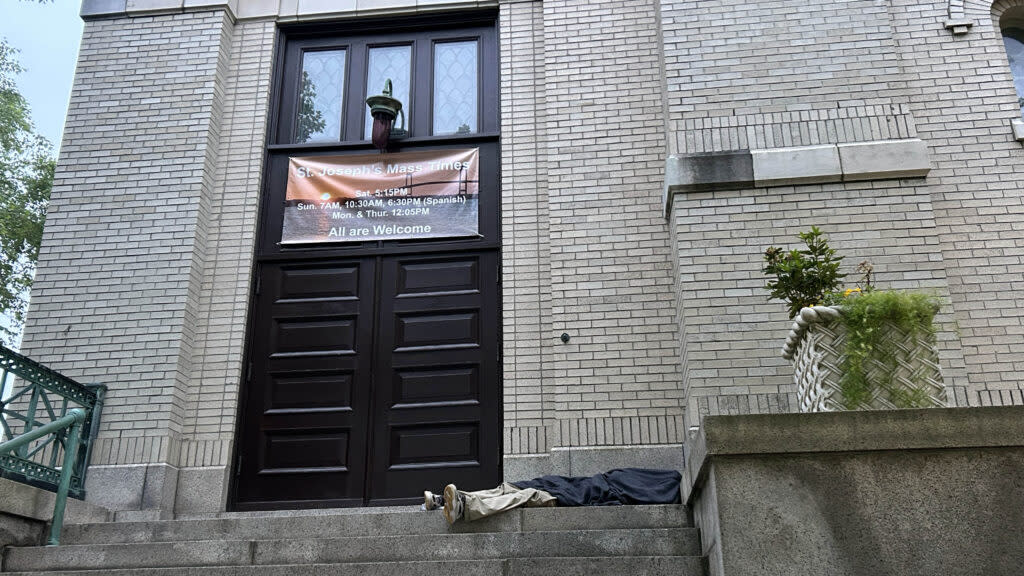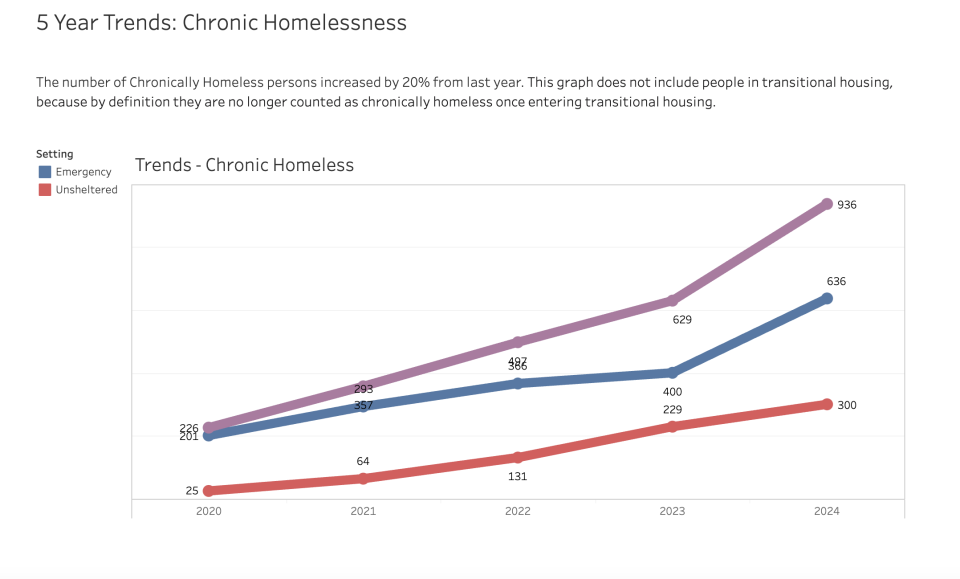Latest census reveals 35% increase in unhoused people in Rhode Island

An individual with no place else to sleep rests on the steps of Saint Joseph's Catholic Church on Broadway in Newport after 8 p.m. on Wednesday, June 26, 2024. (Janine L. Weisman/Rhode Island Current)
The number of unhoused Rhode Islanders has risen 35%, according to the state’s latest Point in Time census released Thursday.
At least 2,442 individuals across the state were counted when volunteers from the Rhode Island Coalition to End Homelessness conducted the annual survey on Wednesday, Jan. 24, 2024, as part of an annual snapshot it conducts for the U.S. Department of Housing and Urban Development. The coalition submits data to the federal government to inform decisions on federal/state funding, advocacy and resource management.
There were 1,810 unhoused people reported in Rhode Island last year.
The coalition’s chief strategy officer, Jennifer Barrerra, said surveys are conducted every January because it’s when unhoused people are most likely to use shelters, making it easier for volunteers to get a count done.
“There’s fewer people, in theory, outside on a night in January than maybe a night in June,” she said.
The release of the annual report came just hours before Rhode Island Housing Secretary Stefan Pryor announced plans to leave his post in two weeks for an unspecified private-sector job. A Department of Housing spokesperson acknowledged a request for comment on the latest Point in Time count, but did not immediately send a response.
Warwick-based community development corporation House of Hope Executive Director Laura Jaworski expressed concern over the increase in the state’s unhoused population, but she was not shocked.
“In some ways, it’s validating because this affirms what my team is seeing on the frontlines,” Jaworski said in an interview. “This is an important snapshot. We know with confidence these numbers are accurate and we know with confidence this is an undercount.”
That is especially true when trying to count the number of young adults — those ages 18-24 — who are experiencing homelessness, Barrerra said. There were 142 young adults recorded in the coation’s survey.

“They’re sometimes hanging out with friends or finding other circumstances — they don’t always present sort of outside in a camping or unsheltered location,” she told reporters after presenting the report at the coalition’s Dyer Street office in Providence.
A total of 936 Rhode Islanders were reported as “chronically homeless,” or those who were unhoused for more than a year and have a substance or mental health disorder. That figure represents a 48.8% increase from the 629 reported last year.
The 2024 survey found 534 people were living unsheltered — a designation that means someone whose primary residence is a car, tent, abandoned building, or other outdoor space. Last year, that number was 334.
A total of 130 homeless veterans were counted this year, up from 100 in 2023.
The increase in homelessness came at a time when the state opened an additional 600 shelter beds compared to what was available in January 2023, Barrera noted.
“If those beds weren’t in place, the number of people outside would have increased to 850,” she said.
The state sought to open 45 one-room cabins within the on-ramp to Route 146 South this spring, but plans have since been pushed to the fall due to what officials are calling “supply chain issues.”
The highest rates of unsheltered people are concentrated in the urban centers of Providence, Pawtucket, and Woonsocket, with the heat map — which denotes large clusters in red and small in green — noting 50 or more. Barrerra said the coalition intends to publish a regional breakdown of Rhode Island’s homeless population by the end of July.
Homelessness advocates pointed to a variety of factors for Rhode Island’s 35% increase — namely a lack of affordable housing and the skyrocketing cost of living.
“Insurance, health, property — it’s everywhere,” Jaworski said
Indeed, a report published by the National Low Income Housing Coalition Thursday found that full-time workers need to earn a wage of $33.20 an hour to afford a two-bedroom apartment at fair market rent in Rhode Island.
But what’s most needed to reduce the state’s ballooning homeless population, Barrera said, is for state, local, and federal entities to provide those most at-risk with the means to either stay in their current home or have a pathway to something permanent.
“If we can get people housed mainstream and not through the homeless response system, that would be helpful,” she said.
GET THE MORNING HEADLINES DELIVERED TO YOUR INBOX
The post Latest census reveals 35% increase in unhoused people in Rhode Island appeared first on Rhode Island Current.

